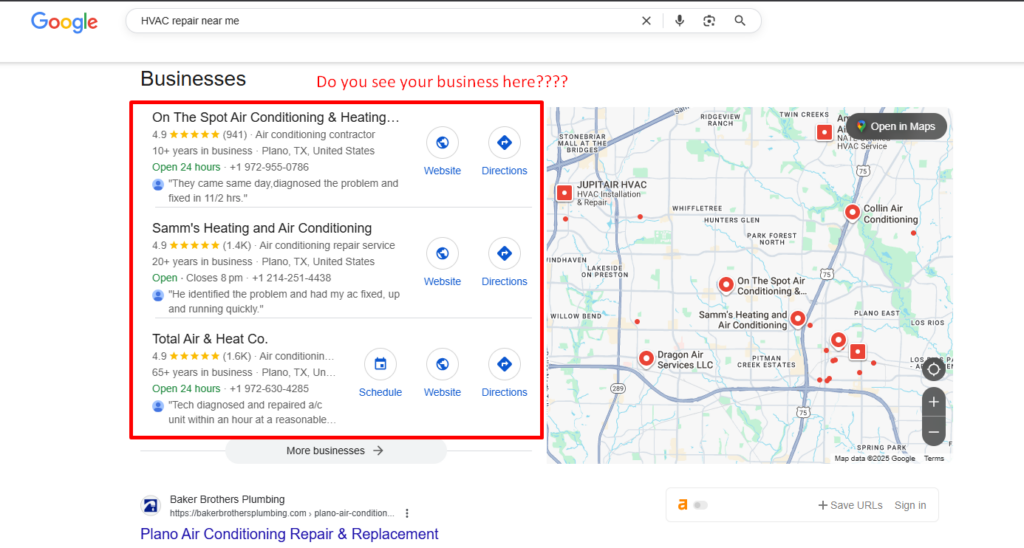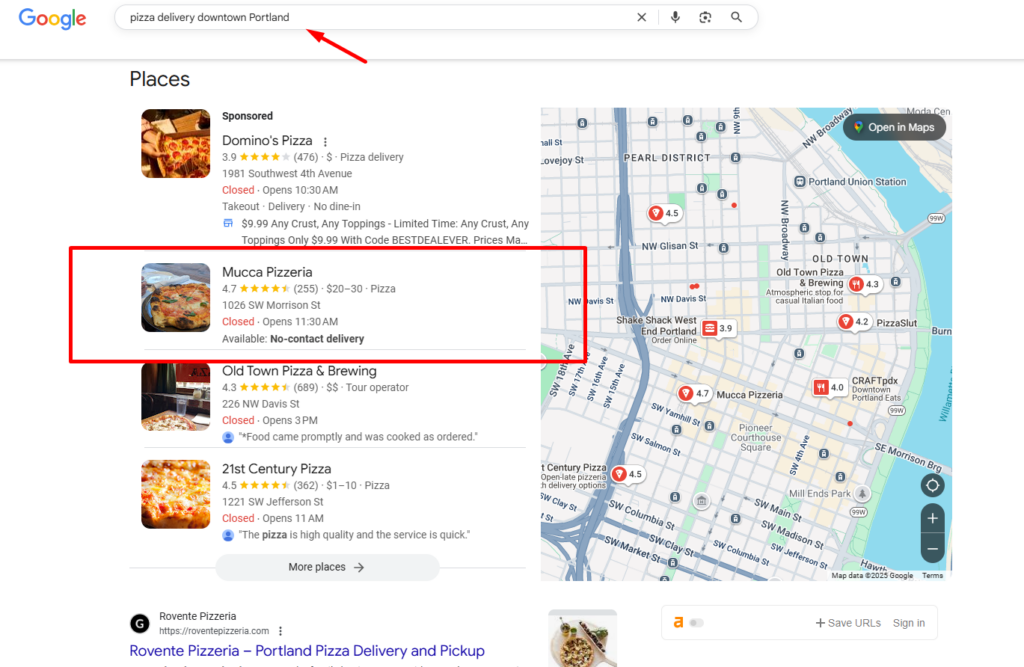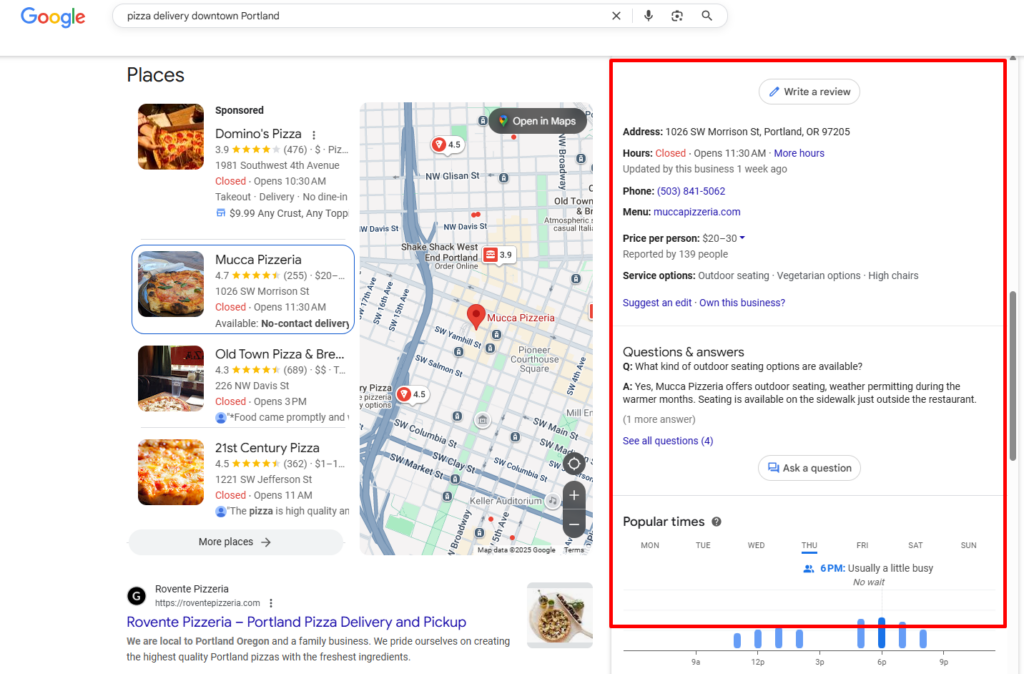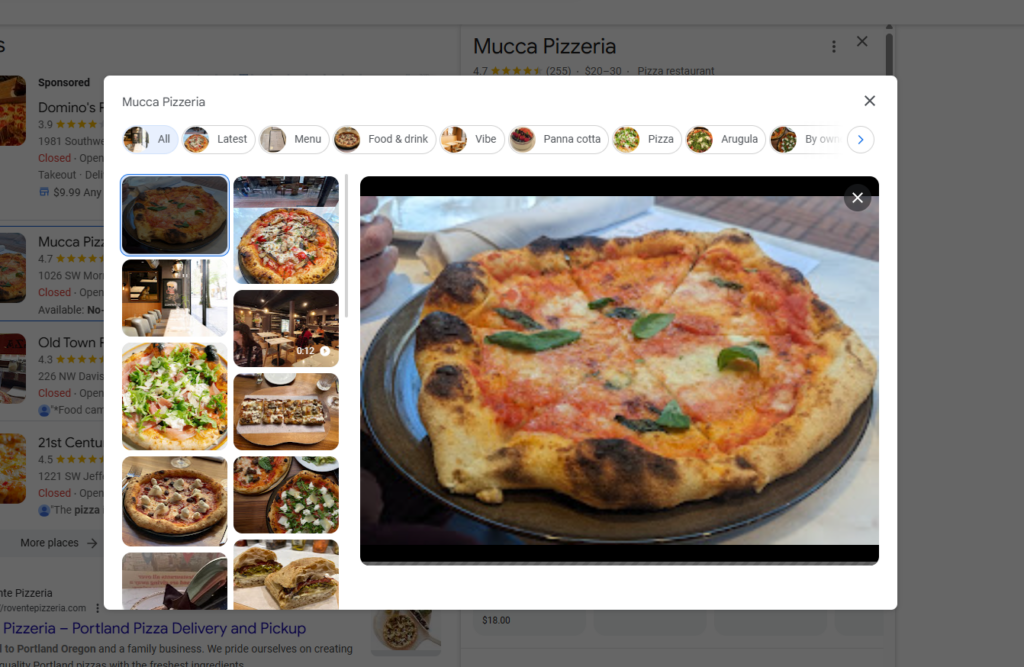“Why don’t customers find me when they search for [what I do] near me?”
If you’ve asked yourself this question, you’re not alone. 96% of people discover businesses near them through online searches, but most local business owners have no clue why their shop, restaurant, or service doesn’t show up when someone literally types “plumber near me” while standing three blocks away.
Here’s the truth: Local SEO isn’t complicated—it’s just different. And it’s the single biggest opportunity staring most local businesses in the face right now.
46% of all Google searches have local intent, and 78% of mobile local searches lead to an offline purchase within 24 hours.
That’s not theory.
That’s your potential customers searching, finding your competitor instead, and buying from them—today.
This guide cuts through the BS and shows you exactly what works, why it matters, and how to actually do it without needing a marketing degree.
Why This Matters for Your Business
Let me be direct: if you’re not showing up in local search results, you’re invisible to the people who are ready to spend money with businesses like yours right now.
Think about it.
When someone searches “HVAC repair near me” at 9 PM because their AC died, they’re not browsing.

They’re buying.
And businesses ranking at the top of local search results capture 24.4% of all clicks—almost a quarter of everyone searching for what you offer.
The good news?
Only 64% of small businesses have a local SEO presence, which means there’s a massive opening for businesses that actually get this right. But that window is closing fast.
Professional local SEO services handle the technical heavy lifting while you focus on running your business—but whether you DIY or hire help, understanding how this works gives you control over one of your biggest customer acquisition channels.
What Is Local SEO? (Plain English Version)
Local SEO is making sure your business shows up when people search for what you do in your area.
That’s it. No jargon, no complexity.
When someone searches “coffee shop downtown” or “dentist open Saturday,” Google shows them a map with three businesses (called the “Local Pack”) and a list of local results.

Local SEO is how you get your business in that map pack and at the top of those local results.
Why Local Search Is Different
Regular SEO fights for national or global visibility. Local SEO fights for the person searching within 5-10 miles of your location. Different game, different rules, different results.
Here’s what makes local search unique:
- Geographic signals matter most – Your physical location, service areas, and proximity to the searcher determine rankings
- Google Business Profile is the main battleground – Not your website (we’ll cover this)
- Reviews and reputation are ranking factors – Not just nice-to-haves
- “Near me” searches dominate – Over 1.5 billion “near me” queries happen every month
How Local Search Actually Works
Google uses three primary factors to determine local rankings:
1. Relevance
Does your business match what the person is searching for? If someone searches “Italian restaurant,” Google checks your business category, description, services, and website content to determine if you’re relevant.
2. Distance
How close is your business to the searcher? This is why the same search in different neighborhoods shows different results. You can’t fake proximity—Google knows where everyone is.
3. Prominence
How well-known and authoritative is your business? Google measures this through reviews, citations (mentions of your business online), website authority, and engagement with your Google Business Profile.
Example: Mucca’s Pizza in Portland ranks #1 for “pizza delivery downtown Portland” because they:

- Set their primary category to “Pizza Delivery Service” (relevance)
- Have their exact address listed and verified (distance)
- Have 255 reviews averaging 4.7 stars with consistent weekly activity (prominence)
Their competitor two blocks away with better pizza but only 12 reviews and an outdated profile? They rank #7 and wonder why Mucca gets all the delivery orders.
Your Google Business Profile: The Foundation
Here’s something most business owners get wrong: your Google Business Profile (GBP) matters more than your website for local search.
I know, I know.
You spent $5,000 on that website.
But your GBP is free and drives more local traffic than almost anything else you can do.
Setting Up Your Profile Right (30-45 Minutes)
Complete every single field.
Not most of them.
All of them.

Google explicitly states that complete profiles perform better in search. Yet most businesses leave half their profile empty and wonder why they don’t rank.
Essential Elements:
- Primary Category – Choose the ONE category that best describes your core business (this is the biggest ranking factor)
- Business Name – Use your actual business name (no stuffing keywords like “Joe’s Plumbing – Best Emergency Plumber Dallas”)
- Address & Service Area – List your exact location if customers visit you, or service areas if you travel to them
- Phone Number – Use a local number, not an 800 number
- Website URL – Link to your website (this drives traffic both ways)
- Hours – Keep these religiously updated, including special hours for holidays
- Business Description – 750 characters to describe what you do, who you serve, and what makes you different
Example: Jackson’s HVAC in Phoenix increased calls by 43% in 60 days by simply completing their profile, adding their service areas (previously blank), and uploading photos every week. Nothing fancy. Just doing what Google asks.
Photos (This is The Hidden Traffic Driver)

Posts and updates are nice. Photos print money.
Businesses with photos receive 42% more requests for directions and 35% more click-throughs to their websites than businesses without photos.
What to upload:
- Exterior shots – So customers can find you
- Interior shots – So they know what to expect
- Team photos – Builds trust and shows you’re real people
- Products/services in action – Before/afters for contractors, dishes for restaurants, happy customers (with permission)
- Upload weekly – Fresh content signals active business
Reviews

Only 48% of consumers would consider using a business with fewer than 4 stars.
Below 4 stars, you’re basically invisible to half your potential customers.
But here’s what most businesses don’t realize: reviews are a ranking factor. More recent, relevant reviews improve your local search visibility directly.
The Review System That Works:
- Ask every happy customer – In person, via email, or text message after service
- Make it stupid simple – Send them the direct link to leave a review (not “find us on Google”)
- Respond to every review – Positive and negative, within 24-48 hours
- Never incentivize reviews – Google will penalize you or remove them
Example: One of our clients, an Auto Repair shop implemented a simple post-service text message asking for reviews. They went from 23 reviews to 147 reviews in 8 months. Their Local Pack ranking jumped from #4 to #1 for “auto repair [city name].”
Revenue increased 34% with zero other marketing changes.
If you need help building a systematic approach to getting reviews and managing your online reputation, this is exactly what professional local SEO services handle daily.
Local Citations: How To Build Your Digital Footprint
A citation is any online mention of your business name, address, and phone number (NAP).
Think business directories, industry sites, social media platforms.
Why Citations Matter
Citations validate your business exists and help Google trust your location data. They’re like digital references confirming “yes, this business is real and located here.”
The Citation Strategy (2-3 Hours Initial Setup)
Phase 1: The Big Players
Get listed on these first:
- Yelp
- Yellow Pages
- Bing Places
- Apple Maps
- Facebook Business Page
Phase 2: Industry-Specific Directories
- Restaurants: TripAdvisor, OpenTable, Zomato
- Contractors: Angie’s List, HomeAdvisor, Houzz
- Medical: Healthgrades, WebMD, Zocdoc
- Legal: Avvo, Justia, FindLaw
Phase 3: Local Directories
Your Chamber of Commerce, local news sites, community pages
Critical Rule: NAP Consistency
Your Name, Address, and Phone number must be identical across every citation. Not similar. Identical.
Wrong:
- “Bob’s Plumbing LLC” vs “Bob’s Plumbing”
- “123 Main Street” vs “123 Main St.”
- “(555) 123-4567” vs “555.123.4567”
These inconsistencies confuse Google and hurt your rankings. Pick one format and use it everywhere.
Website Optimization for Local Search
Your website should do two things:
- Convince humans to call/visit you
- Tell Google exactly what you do and where you serve
On-Page Local SEO Essentials
Location Pages (If You Serve Multiple Areas):
Don’t create thin, duplicate content. Each location page should include:
- Unique local content about that specific area
- Local phone number
- Embedded Google Map
- Customer testimonials from that area
- Neighborhood-specific services or information
Homepage Optimization:
- City/region in your H1 and title tag
- Services clearly listed with local modifiers
- Schema markup (code that tells Google your business details)
- Click-to-call phone number in the header
- Embedded Google Map
Example: A landscaping company we worked with in Tucson created separate pages for each neighborhood they serve (Oro Valley, Catalina Foothills, Marana) with specific content about desert landscaping challenges in each area.
Their traffic increased 89% and they started ranking in Local Pack for multiple neighborhoods instead of just their main location.
Mobile Optimization Is Non-Negotiable
Most local searches happen on mobile. If your site loads slowly or looks broken on phones, you’re done.
The Mobile Checklist:
- Site loads in under 3 seconds
- Phone number is tap-to-call
- Forms work smoothly on mobile
- Text is readable without zooming
- Buttons are finger-friendly
Test your site on your phone right now. Can’t easily find your phone number and call within 10 seconds? Fix that first.
Link Building for Local Businesses
Links = votes of confidence in Google’s eyes.
But local link building is different from regular SEO link building.
Local Link Strategies That Work
1. Sponsor Local Events: Little league teams, charity runs, school fundraisers—most come with a website link
2. Get Featured in Local Media: Local news sites, blogs, community magazines all link to featured businesses
3. Partner With Non-Competing Local Businesses: Cross-promotions, “preferred vendor” lists, community partnerships
4. Chamber of Commerce & Business Associations: Easy wins for local links
5. Guest Post on Local Blogs: Share expertise on local sites in your industry
Lets look at an example…
A local roofing company sponsored youth baseball teams ($500/season) and got linked from the city recreation website, three local news articles about the season, and the league website.
Those 5 links drove more Local Pack visibility than months of other SEO efforts.
Common Local SEO Mistakes (And How Much They’re Costing You)
Mistake #1: Inconsistent Business Information
The Cost: Google can’t confidently show you in search results if your address is different on Yelp vs. your website vs. Facebook. You’re basically training Google that your information is unreliable.
Mistake #2: Ignoring Negative Reviews
The Cost: Unanswered negative reviews tell potential customers you don’t care about problems AND tell Google your business is less trustworthy.
Mistake #3: Not Claiming Your Google Business Profile
The Cost: 40% of small businesses outsource some or all of their local SEO, but many never even claimed their free GBP. That’s like not putting a sign on your storefront.
Mistake #4: Keyword Stuffing Your Business Name
The Cost: Google can suspend your profile for violating guidelines. Then you’re completely invisible until it’s resolved.
Mistake #5: Set-It-and-Forget-It Approach
The Cost: Local SEO requires consistent activity. Posting updates, adding photos, getting reviews—businesses that actively manage their presence consistently outrank inactive competitors.
The Time and Money Reality Check
Let’s talk about what this actually costs in time and money.
DIY Approach
Time Investment:
- Initial setup: 15-20 hours (profile optimization, citations, website fixes)
- Ongoing maintenance: 5-8 hours/month (reviews, posts, photos, monitoring)
Direct Costs:
- Citation management tools: $50-100/month
- Review monitoring: $30-80/month
- Maybe nothing if you do it all manually
Best For: Businesses with tight budgets and someone with 2-3 hours per week to dedicate to this consistently.
Professional Services Approach
Time Investment:
- Your time: 1-2 hours/month (approvals and review responses)
- Professional handling everything else
Direct Costs:
- Local SEO services: $500-2,000/month depending on market competitiveness and service scope
Best For: Businesses where the owner’s time is worth more than the service cost, or where local SEO expertise significantly outweighs DIY learning curve.
ROI Reality: If you’re in a service business where each new customer is worth $500-5,000, you need 1-4 new customers per month to justify professional services. Most established local SEO campaigns drive 10-50+ new customer inquiries monthly.
A comprehensive local SEO service handles profile optimization, citation building, review management, and monthly reporting while you focus on serving customers who are calling because they actually found you.
Your Local SEO Action Plan (Starting Today)
Stop reading guides and start doing things that drive actual results. I have made it as a Local SEO checklist for you.
Week 1: Foundation
- [ ] Claim/optimize Google Business Profile (all fields completed)
- [ ] Add 10-15 photos to GBP
- [ ] Set up review request system
- [ ] Audit NAP consistency (same name, address, phone everywhere)
Week 2: Citations
- [ ] Get listed on top 5 major directories
- [ ] Create/claim 5 industry-specific listings
- [ ] Find 3 local directory opportunities
Week 3: Website
- [ ] Add location-specific content to homepage
- [ ] Create Google Map embed
- [ ] Optimize title tags with location keywords
- [ ] Test mobile experience and fix issues
Week 4: Ongoing Activity
- [ ] Post to Google Business Profile weekly
- [ ] Add 3-5 new photos weekly
- [ ] Ask for 5+ reviews
- [ ] Monitor and respond to all reviews
- [ ] Track Local Pack rankings
Month 2-3: Expansion
- [ ] Create location pages (if serving multiple areas)
- [ ] Build 5-10 local links
- [ ] Expand citations to 30+ directories
- [ ] Analyze competitor strategies
- [ ] Refine based on performance data
Measuring Success of What Actually Matters
Forget vanity metrics. These numbers directly correlate with revenue:
Primary Metrics:
- Local Pack rankings – Where you show up for your main keywords
- GBP impressions and clicks – How many people see and click your profile
- Direction requests – People actively trying to find you
- Phone calls from GBP – Direct conversion metric
- Website traffic from local search – People researching before calling
Secondary Metrics:
- Total review count and average rating
- Review velocity (how many per month)
- Citation count and consistency score
- Local keyword rankings beyond Local Pack
Track monthly. Look for trends over 60-90 days, not week-to-week fluctuations.
Read also: Local SEO vs Traditional SEO: What’s the Real Difference?
The Bottom Line: What This Actually Means for Your Business
Local SEO isn’t mysterious or complicated—it’s systematic.
Most local businesses are mediocre at this, which creates a massive opportunity. Only a third of all businesses find that local SEO is an essential part of their marketing, which means two-thirds of your competitors are ignoring the channel where most of your customers are searching.
Do the basics consistently:
- Complete and optimize your Google Business Profile
- Get reviews systematically
- Build citations with consistent NAP
- Create location-specific website content
- Stay active (posts, photos, updates)
Do these things for 90 days and track your results. If you’re not seeing increased calls, directions requests, and Local Pack visibility, something is technically wrong—not with the strategy, but with the execution.
You have two choices: invest the time to learn and do this yourself, or work with professionals who live and breathe this daily and can compress months of trial-and-error into proven systems.
Either way, the customers are searching. The only question is whether they’ll find you or your competitor.
Ready to dominate local search in your area?
Our team handles everything—from Google Business Profile optimization to review generation and local link building—so you can focus on serving the customers we help you attract. Explore our local SEO services and see how we’ve helped businesses like yours increase local visibility and revenue.
However, first, I suggest using this free tool to audit your GBP and identify what’s missing, as well as how to rectify it.
Read also: